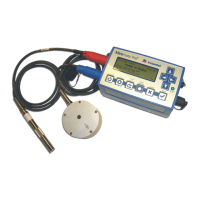Minimate Pro Operator Manual 12–3
complex, or if it contains a large offset value, the zero crossings may lie outside an acceptable
window. Whenever a frequency cannot be calculated the message "<1 Hz" displays. The message
N/A indicates an entire waveform was not captured and therefore no frequency could be
calculated. More accurate analysis is available using the Blastware software.
c. Peak Acceleration
The Minimate Pro calculates peak acceleration, the rate of change of velocity, by dividing the
difference in velocity by the difference in time. To obtain the peak acceleration, the Minimate
Pro subtracts two velocity readings and divides the result by the elapsed time between them.
where:
The Minimate Pro calculates the peak acceleration at each point along the entire waveform and
reports the peak value. Note that this is not necessarily at the peak velocity for an individual
waveform.
d. Peak Displacement
The Minimate Pro calculates peak displacement, or particle distance traveled, by multiplying
speed by time. In the Minimate Pro the interval velocity is multiplied by the time interval and the
resulting displacement segments are summed.
where:
V= the velocity in each interval
To obtain the peak displacement, the Minimate Pro integrates each wave segment of the entire
waveform between zero crossings, selects the largest, then divides the value by half. Note that this
is not necessarily at the peak velocity of the waveform.
e. Peak Vector Sum (PVS)
The figure below displays three Event waveforms. The figure illustrates the procedure of
graphically calculating peak vector sums. Measured magnitudes are tabulated for six different
times and represent velocities in each of the three axes. The vector sum represents the resultant
particle velocity magnitude and is calculated by squaring and adding the magnitudes and taking
the square root.
where:
T = particle velocity along the transverse plane
V = particle velocity along the vertical plane
L = particle velocity along the longitudinal plane

